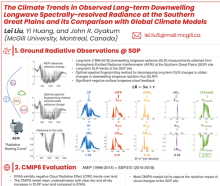The Climate Trends in Observed Long-term Downwelling Longwave Spectrally-resolved Radiance at the Southern Great Plains and its Comparison with Global Climate Models
Lei
Liu
McGill University
Poster
The scientific community has maintained a sustained focus on surface warming, a pivotal indicator of climate change, over the past several decades. Downwelling longwave radiance (DLR), a critical component in the surface energy balance, plays a key role in modulating surface temperature. The long-term DLR record at the Southern Great Plains (SGP) site has been homogenized through observations from two Atmospheric Emitted Radiance Interferometers (AERIs) deployed there. This precise and highly sought-after radiance record, referred to as the “Radiative Keeling Curve”, reveals unambiguous climate change signals through a fingerprinting method decomposition. Prominent components include surface warming, positive CO2 surface forcing, negative O3 surface forcing, positive water vapor feedback, and negative cloud feedback.
The trends in DLR, coupled with spectral contributions from diverse meteorological variables, offer a valuable opportunity for diagnosing Global Climate Models (GCMs). Outputs from the Community Earth System Model v2 Large Ensemble (CESM2 LENS), specifically within the grid box containing the SGP site, serve as input for Line-by-Line Radiative Transfer Model (LBLRTM) to generate a synthetic long-term DLR record. This synthetic record is systematically compared with the observed DLR record, facilitating a comprehensive evaluation of model performance. Furthermore, the diagnostic contribution from different drivers guides improvements in model performance at a climate processing level.
The trends in DLR, coupled with spectral contributions from diverse meteorological variables, offer a valuable opportunity for diagnosing Global Climate Models (GCMs). Outputs from the Community Earth System Model v2 Large Ensemble (CESM2 LENS), specifically within the grid box containing the SGP site, serve as input for Line-by-Line Radiative Transfer Model (LBLRTM) to generate a synthetic long-term DLR record. This synthetic record is systematically compared with the observed DLR record, facilitating a comprehensive evaluation of model performance. Furthermore, the diagnostic contribution from different drivers guides improvements in model performance at a climate processing level.

Poster file
liu-lei-confrontin-poster.pdf
(2.04 MB)
